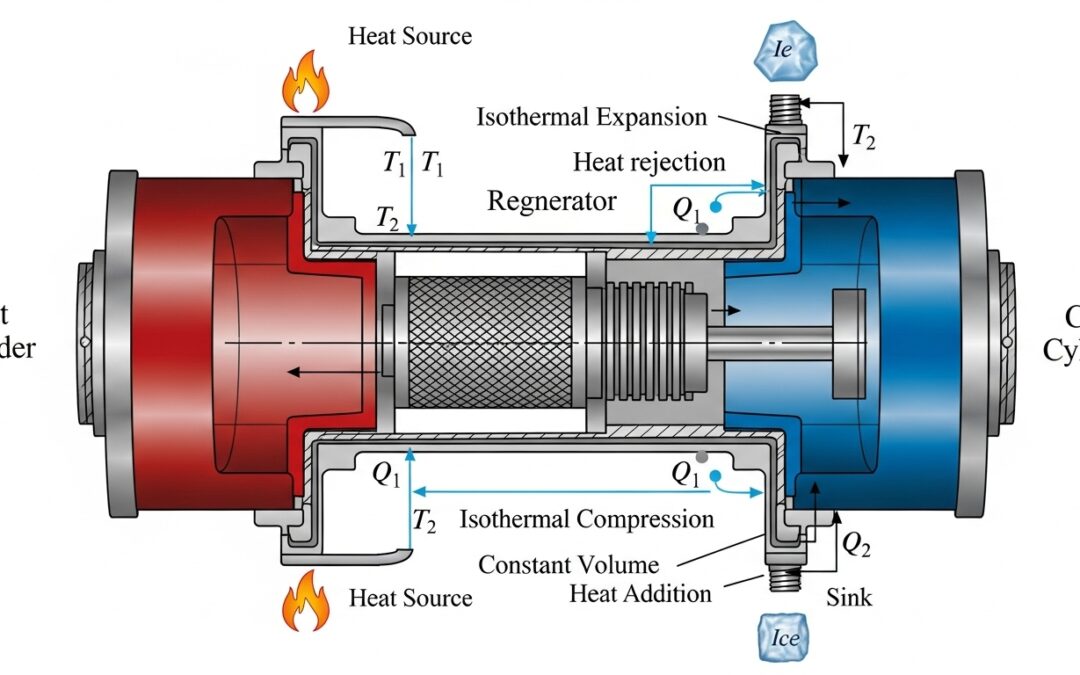The concept of latent heat of fusion is crucial in understanding phase transitions in substances. You’ll learn to solve a latent heat fusion problem to determine the energy required for a solid to liquid transformation, such as ice melting into water. This knowledge is fundamental in various scientific and engineering applications, from climate science to industrial processes.
Table of Contents
- Understanding Latent Heat of Fusion
- What is Latent Heat?
- The Formula for Latent Heat of Fusion
- Breaking Down the Formula
- Illustrative Example
- Key Points About Latent Heat of Fusion
- Quick Reference Table
- Latent Heat vs. Specific Heat Capacity
- Specific Heat Capacity
- Latent Heat
- Key Differences
- Analogy
- Example Problem (Fusion)
- Solving a Latent Heat Fusion Problem
- Similar Problems
- Latent Heat of Fusion — Solved Problems
- Problem 1: Melting 1 kg of Ice
- Problem 2: Melting 0.5 kg of Ice
- Problem 3: Heat to Melt Ice
- Problem 4: Melting 3 kg of Ice
- Problem 5: Melting 0.25 kg of Ice
- Summary of Results
- Key Takeaways
Read More
Welcome, aspiring physicists and science enthusiasts! This guide delves into the fascinating world of phase transitions, specifically focusing on the concept of latent heat of fusion. We will learn how to quantify the energy involved when a substance transforms from a solid to a liquid state, a process that is crucial in various scientific and engineering applications. Let’s begin our journey to understand how to solve a latent heat fusion problem.
Understanding Latent Heat of Fusion
Latent heat of fusion is the amount of energy required to change one kilogram of a substance from solid to liquid at a constant temperature. This energy input breaks the bonds holding the solid structure together, allowing the molecules to move more freely in the liquid state. Think of it as the energy needed to untangle a tightly packed ball of yarn, allowing the individual strands to separate.
What is Latent Heat?
Latent heat refers to the energy absorbed or released during a phase transition without a change in temperature. It is a critical concept in understanding how substances change states. The term “latent” means hidden, as the energy goes into changing the state rather than raising the temperature. This energy is used to overcome the intermolecular forces within the substance.
The latent heat of fusion is specific to each substance. For example, the latent heat of fusion for water (ice) is significantly different from that of metals like iron or aluminum. This difference arises from the varying strengths of the intermolecular forces and the arrangement of atoms or molecules within the solid structure. The amount of energy required to melt a substance directly reflects these forces.
The concept of latent heat is essential for understanding various natural phenomena and technological processes. It is crucial in climate science, where the melting of ice and snow influences global temperatures, and in industrial applications like metal casting, where precise control of melting and solidification is critical. You need to understand how to solve a latent heat fusion problem to appreciate these applications.
The Formula for Latent Heat of Fusion
The relationship between the heat (Q) absorbed or released during a phase change, the mass (m) of the substance, and the latent heat of fusion (Lf) is expressed by the formula: ##Q = mL_f##. This formula is straightforward but incredibly powerful in predicting the energy requirements for phase transitions. Let’s break down the components.
Where Q represents the heat energy measured in Joules (J) or Kilojoules (kJ), m is the mass of the substance in kilograms (kg), and Lf is the latent heat of fusion measured in Joules per kilogram (J/kg) or Kilojoules per kilogram (kJ/kg). This equation is fundamental to solving problems related to phase changes. It highlights the direct proportionality between the heat absorbed or released and the mass of the substance.
Understanding this formula is crucial. For instance, if you know the latent heat of fusion for ice (334 kJ/kg) and the mass of the ice, you can calculate the energy needed to melt it. This calculation does not involve any temperature change; the energy is solely used to break the bonds holding the ice crystals together. The constant temperature during the phase change is a key characteristic.
The Formula for Latent Heat of Fusion
The latent heat of fusion quantifies the heat required to change a substance from solid to liquid (or vice versa) at a constant temperature. The fundamental relation is:
### Q = m \cdot L_f ###
- Q → Heat absorbed or released (in joules, J, or kilojoules, kJ)
- m → Mass of the substance (in kilograms, kg)
- Lf → Latent heat of fusion (in J/kg or kJ/kg)
Breaking Down the Formula
This formula shows that the amount of heat required for a phase change is directly proportional to the mass of the substance. Larger masses demand proportionally more energy to undergo fusion or solidification.
Unlike specific heat capacity calculations, this equation does not involve temperature change. Instead, all the absorbed heat goes into overcoming the molecular bonds holding the solid lattice together. During this process, the temperature of the substance remains constant until the phase change is complete.
Illustrative Example
Suppose we want to calculate the heat required to melt 2 kg of ice at 0°C. The latent heat of fusion of ice is:
### L_f = 334 \,\text{kJ/kg} = 334{,}000 \,\text{J/kg} ###
Applying the formula:
### Q = m \cdot L_f = 2.0 \cdot 334{,}000 = 668{,}000 \,\text{J} = 668 \,\text{kJ} ###
Thus, 668 kJ of energy is required to completely melt 2 kg of ice at 0°C into water at 0°C.
Key Points About Latent Heat of Fusion
- The process occurs at a constant temperature (0°C for ice).
- Heat supplied is used for breaking intermolecular bonds, not raising temperature.
- The formula is linear: doubling the mass doubles the heat required.
- Values of ##L_f## vary across substances; water (ice) has a relatively high latent heat of fusion, making it vital in climate regulation.

Quick Reference Table
| Substance | Latent Heat of Fusion (kJ/kg) | Remarks |
|---|---|---|
| Water (ice) | 334 | High value; essential for Earth’s heat balance |
| Lead | 23 | Low value; melts with relatively little energy |
| Iron | 247 | Significant energy required to melt |
Latent Heat vs. Specific Heat Capacity
It’s crucial to differentiate between latent heat of fusion and specific heat capacity. Specific heat capacity, often denoted as ‘c’, quantifies the amount of heat required to raise the temperature of one kilogram of a substance by one degree Celsius (or Kelvin). This process occurs without a phase change. The formula is ##Q = mcΔT##, where ΔT is the change in temperature.
Specific heat capacity describes the energy needed to change the temperature of a substance. Latent heat, on the other hand, describes the energy needed to change the phase of a substance at a constant temperature. Both concepts are essential in thermodynamics, but they address different aspects of energy transfer. The key difference lies in whether the temperature remains constant during the process.
In summary, specific heat capacity relates to temperature changes, whereas latent heat relates to phase changes. You can think of specific heat as the energy needed to make a substance “hotter” or “colder,” while latent heat is the energy needed to change its “form.” Both concepts are fundamental in thermodynamics and are used extensively in engineering and scientific applications. Now, let’s see how to solve a latent heat fusion problem.
In thermodynamics, two closely related but fundamentally different concepts are specific heat capacity and latent heat. Both describe how substances absorb or release energy, but they apply in different scenarios: one deals with temperature changes, the other with phase changes.
Specific Heat Capacity
Specific heat capacity, denoted by ##c##, is the heat required to raise the temperature of one kilogram of a substance by one degree Celsius (or Kelvin). The formula is:
### Q = m \cdot c \cdot \Delta T ###
- Q = heat absorbed or released (J or kJ)
- m = mass of the substance (kg)
- c = specific heat capacity (J/kg·K)
- ΔT = change in temperature (°C or K)
This relation is valid when there is no phase change, and the temperature of the material changes smoothly. For example, heating 1 kg of copper from 25°C to 75°C involves specific heat.
Latent Heat
Latent heat, often expressed as the latent heat of fusion (##L_f##) or latent heat of vaporization (##L_v##), refers to the heat required to change the phase of a substance at a constant temperature. The formula is:
### Q = m \cdot L ###
- Q = heat absorbed or released (J or kJ)
- m = mass (kg)
- L = latent heat constant (J/kg or kJ/kg)
Here, the added heat does not change temperature but instead breaks or forms molecular bonds, such as melting ice into water or boiling water into steam.

Key Differences
| Aspect | Specific Heat Capacity | Latent Heat |
|---|---|---|
| Definition | Heat required to raise the temperature of 1 kg of a substance by 1°C | Heat required to change the phase of 1 kg of a substance without temperature change |
| Formula | ### Q = mc\Delta T ### | ### Q = mL ### |
| Temperature | Changes during the process | Remains constant during the process |
| Application | Heating or cooling within a single phase | Melting, freezing, boiling, condensation |
| Energy Use | Increases or decreases molecular kinetic energy | Breaks or forms intermolecular bonds |
Analogy
You can think of specific heat capacity as the energy needed to make something hotter or colder. In contrast, latent heat is the energy needed to make something change its form (e.g., solid → liquid → gas) while staying at the same temperature.
Example Problem (Fusion)
Problem: How much energy is required to melt 0.5 kg of ice at 0°C? (##L_f = 334 \,\text{kJ/kg}##)
Solution:
### Q = m \cdot L_f = 0.5 \cdot 334 = 167 \,\text{kJ} ###
Answer: 167 kJ of energy is required to convert 0.5 kg of ice into water at 0°C.
Solving a Latent Heat Fusion Problem
Now, let’s apply the concepts to a practical problem: Calculating the heat required to melt ice. This will help you understand how to solve a latent heat fusion problem in a real-world scenario. We will work through the steps to ensure you grasp the underlying principles and can apply them confidently. This problem illustrates the energy required for a phase change.
Problem Statement
Calculate the amount of heat required to melt 2.0 kg of ice at 0°C into water at 0°C. The latent heat of fusion for ice is 334 kJ/kg.
We will use the formula ##Q = mL_f## to solve this. We know the mass of the ice (m = 2.0 kg) and the latent heat of fusion for ice (Lf = 334 kJ/kg). The problem involves a phase change from solid to liquid at a constant temperature. No temperature change is involved, so we only need to consider the latent heat.
The solution involves a single calculation. The simplicity of the formula makes the calculation straightforward, but the result highlights the significant energy involved in phase changes. This example demonstrates the importance of understanding latent heat in various applications, from everyday phenomena to industrial processes. It is the core of how to solve a latent heat fusion problem.
Step-by-Step Solution
To calculate the heat (Q), we use the formula ##Q = mL_f##. We substitute the values for mass (m = 2.0 kg) and latent heat of fusion (Lf = 334 kJ/kg) into the equation. This step is a direct application of the formula and helps to solidify the concept. The units must be consistent throughout the calculation.
Substituting the values: ##Q = 2.0 kg × 334 kJ/kg##. This step is a straightforward multiplication, ensuring the correct values are used. The result is the total energy required to melt the ice. This calculation is a direct application of the formula.
Calculating the result, we get ##Q = 668 kJ##. Therefore, 668 kJ of energy is required to melt 2.0 kg of ice at 0°C into water at 0°C. This demonstrates how much energy is involved in a simple phase change. The large value emphasizes the importance of understanding latent heat. It highlights the significant energy involved in the phase transition.
Similar Problems
Here are some similar problems to practice and reinforce your understanding of latent heat of fusion. Each problem provides a brief solution to check your work and further enhance your skills in solving phase transition problems.
- Problem 1: How much heat is required to melt 1 kg of ice at 0°C? (Lf = 334 kJ/kg)
- Problem 2: Calculate the heat needed to melt 0.5 kg of ice. (Lf = 334 kJ/kg)
- Problem 3: If 1000 kJ of heat is added to ice, how much ice can be melted? (Lf = 334 kJ/kg)
- Problem 4: Determine the heat required to melt 3 kg of ice. (Lf = 334 kJ/kg)
- Problem 5: How much energy is needed to change 0.25 kg of ice to water? (Lf = 334 kJ/kg)
Latent Heat of Fusion — Solved Problems
These problems involve the latent heat of fusion (##L_f##), which is the heat required to change a unit mass of ice at 0°C into water at 0°C without any change in temperature. The relation used is:
### Q = m \cdot L_f ###
- ##Q## = heat energy (in joules or kilojoules)
- ##m## = mass of ice (in kilograms)
- ##L_f## = latent heat of fusion (334 kJ/kg)
Problem 1: Melting 1 kg of Ice
Given: Mass ##m=1.0\,\text{kg}##, ##L_f=334\,\text{kJ/kg}##.
### Q = 1.0 \cdot 334 = 334 \,\text{kJ} ###
Answer: 334 kJ of heat is required.
Problem 2: Melting 0.5 kg of Ice
Given: ##m=0.5\,\text{kg}##, ##L_f=334\,\text{kJ/kg}##.
### Q = 0.5 \cdot 334 = 167 \,\text{kJ} ###
Answer: 167 kJ of heat is required.
Problem 3: Heat to Melt Ice
Given: Heat available ##Q=1000\,\text{kJ}##, ##L_f=334\,\text{kJ/kg}##.
### m = \dfrac{Q}{L_f} = \dfrac{1000}{334} \approx 2.99\,\text{kg} ###
Answer: About 2.99 kg of ice can be melted.
Problem 4: Melting 3 kg of Ice
Given: ##m=3.0\,\text{kg}##, ##L_f=334\,\text{kJ/kg}##.
### Q = 3.0 \cdot 334 = 1002 \,\text{kJ} ###
Answer: 1002 kJ of heat is required.
Problem 5: Melting 0.25 kg of Ice
Given: ##m=0.25\,\text{kg}##, ##L_f=334\,\text{kJ/kg}##.
### Q = 0.25 \cdot 334 = 83.5 \,\text{kJ} ###
Answer: 83.5 kJ of heat is required.
Summary of Results
| Problem | Mass of Ice (kg) | Heat Supplied (kJ) | Result |
|---|---|---|---|
| 1 | 1.0 | 334 | 1 kg of ice melted |
| 2 | 0.5 | 167 | 0.5 kg of ice melted |
| 3 | ≈2.99 | 1000 | 2.99 kg of ice melted |
| 4 | 3.0 | 1002 | 3 kg of ice melted |
| 5 | 0.25 | 83.5 | 0.25 kg of ice melted |

Key Takeaways
In conclusion, solving a latent heat fusion problem is a fundamental skill in physics and engineering. The formula ##Q = mL_f## allows us to quantify the energy required for phase transitions, a concept crucial in understanding various natural and technological processes. Through practical examples, we’ve seen how to apply this formula and appreciate the energy dynamics involved in melting ice.
Remember, understanding latent heat is essential for comprehending phase changes. With this knowledge, you are well-equipped to tackle more complex problems involving heat transfer and phase transitions. Keep practicing, and your understanding will continue to grow!
| Concept | Explanation | Formula |
|---|---|---|
| Latent Heat of Fusion (Lf) | The amount of energy required to change one kilogram of a substance from solid to liquid at a constant temperature. | ##Q = mL_f## |
| Specific Heat Capacity (c) | The amount of heat required to raise the temperature of one kilogram of a substance by one degree Celsius (or Kelvin). | ##Q = mcΔT## |
| Units | Heat (Q): Joules (J) or Kilojoules (kJ), Mass (m): Kilograms (kg), Latent Heat of Fusion (Lf): J/kg or kJ/kg |
We also Published
RESOURCES
- Heat of Fusion Example Problem
- Using Latent Heat of Fusion to Calculate Energy Needed to Change …
- Latent Heat of Fusion – GeeksforGeeks
- Help with thermodynamics problem (latent heat and calorimetry) : r …
- A review of materials, heat transfer and phase change problem …
- 11.3 Phase Change and Latent Heat – Physics | OpenStax
- Heat of Fusion Problems and Solutions
- Latent Heat & Phase Changes Practice Problems | Test Your Skills …
- Heat of Fusion Equation Example Problem – Melting Ice
- Solved (20%) Problem 5: A thermos contains m1 = 0.74 kg | Chegg …





0 Comments